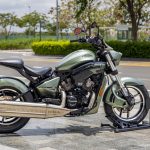When discussing the origin of the Halogen bulb, it is important to mention the traditional filament bulbs that were used in cars during the 1940s. These filament bulbs were gradually replaced by halogen bulbs in the late 1970s. While still housed in sealed capsules, the light emitted by halogen bulbs is significantly improved compared to filament bulbs. In the 1980s, it became possible to replace just the bulb without having to change the entire lamp. This allowed car and motorcycle manufacturers to design headlights in different styles and types.
It must be acknowledged that equipping products with a halogen bulb system seems to be a common practice for many motorcycle manufacturers in Vietnam. This type of bulb has a relatively low production cost and a simple construction.
.jpg)
On the other hand, motorcycle users in Vietnam, especially motorcycle enthusiasts, have gradually moved away from using halogen bulbs. They prefer bulbs that provide higher lighting efficiency, which often come with more complex structures and higher investment costs.
A few facts about Halogen bulbs
To create the core part of the bulb, manufacturers use a large amount of quartz glass. This material can withstand high temperatures and pressures, making the filament brighter and the bulb’s lifespan longer than regular filament bulbs.
Back in the early days, when headlights were made with sealed capsules, replacing a burnt-out bulb meant replacing the entire headlight. Different manufacturers had different standards, so special attention should be paid to the socket, shape, size, and color temperature when choosing a replacement bulb. The original bulbs on motorcycles usually work in the temperature range of 4,100-4,300 Kelvin, emitting light similar to daylight. If the emitted light has a slightly blue or purple color, it is around 5,000-6,000 Kelvin. A higher color temperature does not mean brighter light; it simply changes the color of the emitted light.
Halogen bulbs have significantly longer lifespans compared to traditional filament bulbs. By using an additional halogen gas, they prevent the filament from evaporating at high temperatures, which can cause the filament to break. It is worth noting that low-quality or counterfeit bulbs may quickly burn out or have the filament placed in the wrong position, reducing brightness at night.
Disadvantages of Halogen bulbs
Although Halogen bulbs have clear advantages such as simple construction, easy replacement and repair, and relatively low replacement costs, they also have several drawbacks that can be bothersome to those who demand more from their headlights.
.jpg)
Firstly, let’s discuss the construction of Halogen bulbs. These bulbs are made of a type of glass that can withstand high temperatures. The filament, made of tungsten wire, is surrounded by gas, usually argon and nitrogen. To emit light, the filament receives electrical energy from the battery, heating up to around 2,500 degrees Celsius. Therefore, a large amount of electrical energy from the battery is wasted as heat energy, causing the outer lens’ temperature to increase significantly and potentially posing a danger when touched after prolonged use.
Over time, the high temperature causes the tungsten wire filament to slowly vaporize, leaving deposits on the glass part of the bulb. These deposits can puncture the thin glass layer and reduce the bulb’s performance.
While Halogen bulbs have a relatively simple maintenance and replacement process, carelessness during the replacement process can cause the reflective and light-amplifying coating to become dirty, resulting in decreased lighting function.
Another issue is the reaction of Halogen bulbs with certain substances. For example, when replacing a broken bulb, touching the glass envelope should be avoided, as the salt in sweat can reduce the bulb’s lifespan.
Replacement solutions
Nowadays, replacing the lighting system for motorcycles, often referred to as “customizing headlights,” is not a difficult task for motorcycle enthusiasts. In Hanoi alone, there are several facilities and centers specializing in customizing the original halogen headlight system of motorcycles by replacing it with a Bi-xenon or Projector system.
Replacing the original halogen bulb headlight assembly on a motorcycle with a Bi-xenon or Projector system requires time and comes with a relatively high cost. However, Bi-xenon headlights offer energy savings and much brighter light compared to regular halogen headlights. It is worth noting that the very bright light of xenon bulbs can blind oncoming drivers. Under normal conditions, xenon bulbs have an average lifespan of about 2,000 hours.
.jpg)
Recently, many mid-range to high-end motorcycles have opted not to use the old-generation halogen headlight system. For example, the 2016 Honda Airblade model utilizes full LED technology. LED stands for Light-Emitting Diode. LED bulbs are based on semiconductor technology, where the movement of electrons within the semiconductor chip produces radiation of various colors.


In conclusion, different manufacturers continuously introduce new technologies to showcase their capabilities, and headlights are no exception. From simple acetylene bulbs in the 1980s to complex LED and laser technologies today, headlight technology has come a long way.
Technologically speaking, many users believe that newer technology is superior, specifically Bi-xenon or Projector headlights. However, each type has its own advantages and disadvantages, and there is no perfect type of headlight.
- The risks of modified motorcycle lights
- Laser headlight technology on the BMW i8
- From Bi-Xenon to “5-in-1” headlights
Trung Hieu (Trithucthoidai.vn)










































![[CAR REVIEW] Hyundai Palisade 2023 Coming to Vietnam: “Worth Every Penny”](https://vnauto.net/wp-content/uploads/2023/10/xehay-hyundaipalisade-13062023-1-100x70.jpg)
![[CAR REVIEW] Volvo XC60 Ultimate Recharge: “2022’s Car of the Year” – Does it live up to the hype?](https://vnauto.net/wp-content/uploads/2024/02/xehay-volvoxc60recharge-28042023-23-100x70.jpg)
![[CAR REVIEW] Mitsubishi Xpander Cross: A Worthy Leader](https://vnauto.net/wp-content/uploads/2023/11/xehay-mitsubishixpandercross-08052023-16-100x70.jpg)